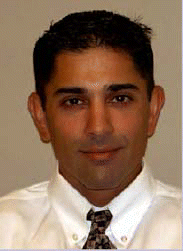If FESS is to be performed standing up, Dr. Han suggested putting patients in a semireclined “beach chair” position so the endoscope, once in the nasal cavity, is parallel to the patient’s skull base.
Explore This Issue
December 2006If a patient is supine, “the normal tendency is to work toward the skull base. It’s natural for us in this position, [when the patient is lying down] to look up.…Look back, so you go toward the sphenoid sinus rather than looking up into the skull base,” Dr. Han said.
In addition, endoscopic views provide only a partial view of the surgical field. Also, the view can be altered by anatomic variations. For instance, with a deviated septum the otolaryngologist tries to keep the endoscopic view in the center of the surgical field between the septum and the lateral nasal wall. The endoscope will be pushed toward the orbit. The surgeon has to “constantly refocus and examine where you are in the big surgical field,” Dr. Han said.
Other tips include having good lighting for the endoscope, minimizing trauma and bleeding so the tissue planes can be found, and being meticulous and specific in how instruments are used. Nasal constrictor medication helps too.
Sphenoid Sinus Surgery
Peter Batra, MD, Assistant Professor of Surgery at the Cleveland Clinic, addressed surgery of the sphenoid sinus. Knowing the anatomy is vital. The superior turbinate is an important landmark, which leads to the sphenoid ostium.
The sphenoid sinus has “an intimate relationship to the internal carotid artery, the pituitary gland, and multiple cranial nerves including optic nerve, V2, and the vidian nerves. If we go into the sphenoid sinus, we have to be aware of these structures,” he said.
Don’t assume there are bony coverings over critical structures such as the optic nerve. CT studies of cadavers have shown “about a fifth of the time there are not any bony coverings,” he said.
As for the surgical approach, either transnasal or transethmoid sphenoidotomy may be utilized, depending on the pathology. Generally, the transnasal is the simplest and most direct, with indications including isolated sphenoid inflammatory disease, endoscopic pituitary disease, and central sphenoclival pathology.
The transethmoid route is appropriate in cases of diffuse inflammatory sinonasal disease and benign and malignant sinonasal neoplasms; the transmaxillary approach is used for lateral sphenoid CSF leaks.
No matter which approach is used, it’s vital to have “a careful review of the preoperative imaging prior to the execution of surgery,” and know where the critical structures are, Dr. Batra said.
Frontal Sinus Procedures
Alexander G. Chiu, MD, Assistant Professor of Rhinology at the University of Pennsylvania, addressed surgery of the frontal sinus.

Leave a Reply